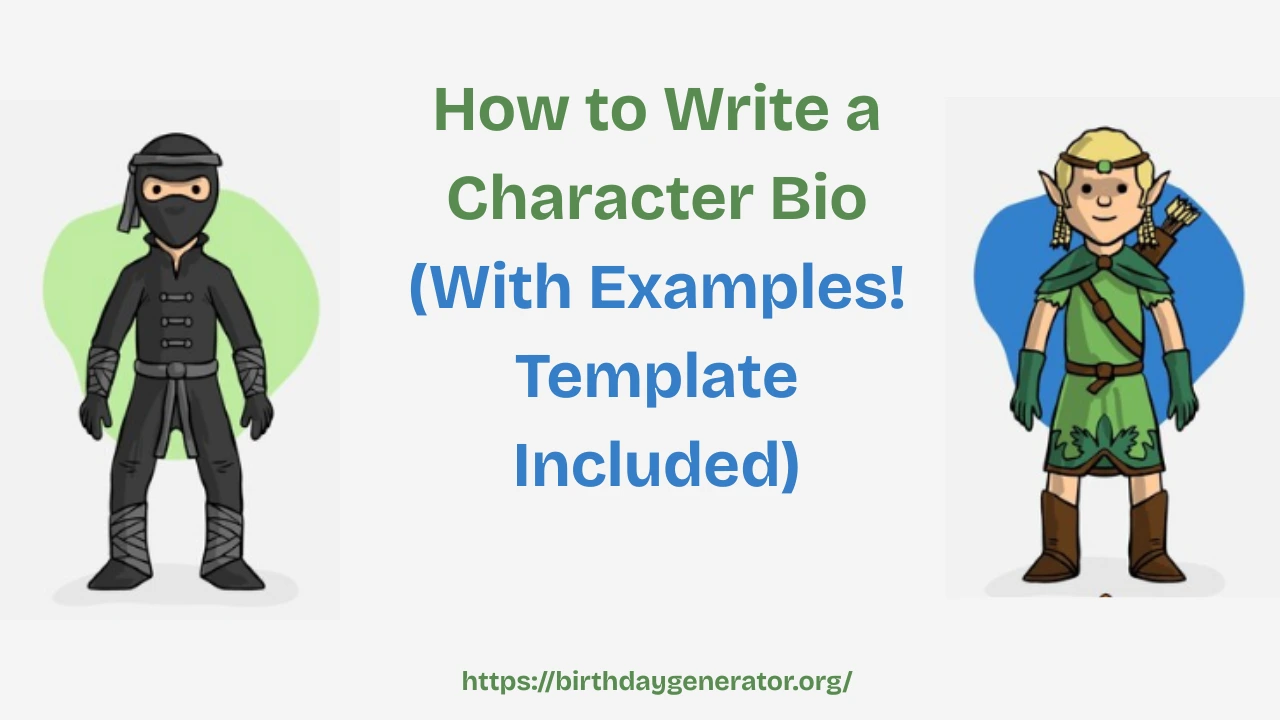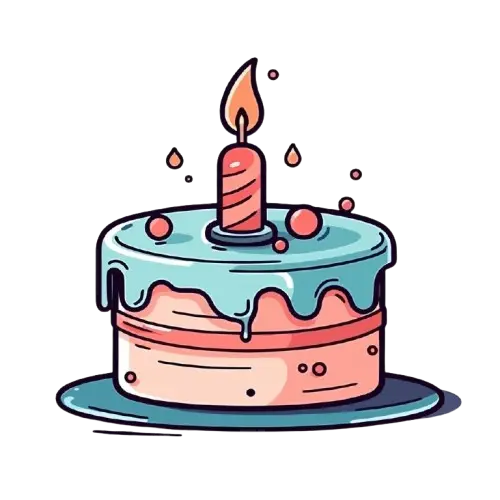How to Write a Character Bio (With Examples! Template Included)

Writing a compelling character can be challenging. You might find yourself stuck, not knowing how to make your characters feel real, consistent, or engaging. It’s frustrating when you put so much time into your plot. but don’t feel under the weather.
The solution is in creating a well-crafted character bio. The character bio serves as the foundation for everything about your character—who they are, what they want, and what makes them more. It provides a clear and concise reference that ensures your character remains consistent and fully developed throughout the story.
In this post, we’ll show you exactly How to Write a Character Bio, what to avoid. We’ll also share a useful technique, like using a random birthday generator, to inspire fresh details that make your character’s backstory even more unique.
As George R.R. Martin once said, “A character is like a tree: you have to know the roots before you can see the branches.”
By understanding your character deeply, you can create a narrative that truly resonates.
Let’s get started.
What is a Character Bio/Profile?
A character bio is a concise outline of a character’s essential traits, backstory, and motivations. It helps writers develop characters who are consistent and believable, and serves as a foundation for how they will behave and evolve in the story.
The bio typically includes details such as the character’s name, age, appearance, personality, backstory, goals, and any special skills or weaknesses. It ensures that the character’s actions align with their history and motivations, making them more engaging and real.
It’s the blueprint for developing a character who feels real, and it can guide you throughout the entire writing process.
Why is a Character Bio Important?
A character bio is important because it keeps your character consistent and believable. It helps you understand their motivations, strengths, and weaknesses, ensuring their actions align with their personality. This makes your character more realistic and engaging for your audience.
Here is an example of character bio:
Sarah Bennett is a 30-year-old investigative journalist. She’s sharp, fearless, and always digging for the truth. With short dark hair and glasses, she has a professional look, often dressed in smart casual. Raised by a police officer, Sarah developed a passion for exposing corruption. Driven by justice, she sometimes makes reckless choices, putting her work above personal life. She’s great at research and interviews, but struggles to find balance.
How Long Should a Character Bio Be?
A character bio should be concise yet comprehensive, typically ranging from 150 to 300 words. It should cover essential details like the character’s appearance, personality, backstory, motivations, and goals. This length allows you to provide enough information to build a strong foundation for your character while keeping it manageable. Think of it as laying the groundwork—just enough to guide your character’s actions and development without overwhelming you with unnecessary details. Keep it clear and focused, ensuring that every word adds value to your character’s depth.

6 Key Elements to Include in Your Character Bio
1. Basic Information
The basic information of a character provides the foundation for their identity in the story. This includes details like their name, age, occupation, and physical appearance, all of which help readers to form a clear image of the character in their mind.
What to Include:
- Full name
- Age
- Gender
- Occupation or role in the story
- Physical description (height, hair color, eye color, etc.)
- Distinguishing features (scars, tattoos, etc.)
By including these basics, you make yours the character feel grounded and realistic. For example, a character described as “John, a 35-year-old mechanic with broad shoulders and a scar on his left cheek” helps the reader immediately visualize this character. Simple but effective details like these are the first building blocks of your character’s identity.
2. Personality Traits
A character’s personality is what drives their behavior and decisions throughout the story. By adding character’s strengths, weaknesses, and preferences, you help readers to relate to or be interested in story.
What to Include:
- Core personality traits (e.g., courageous, kind, sarcastic)
- Strengths (e.g., loyalty, intelligence)
- Weaknesses (e.g., impatience, fear of failure)
- Likes and dislikes (e.g., hobbies, preferences, fears)
- Behavior under stress (how they react in difficult situations)
By defining their personality, you ensure your character feels authentic. For example, a character who is generally kind but has a fear of abandonment may act impulsively when faced with the loss of a loved one. These traits should influence their decisions and behavior. Remember, no one is perfect, flaws make them more interesting.
3. Backstory & Life Events
A character’s backstory is their history before the events of the story take place. Their upbringing, experiences, and relationships all play a crucial role in shaping who they are and why they act the way they do.
What to Include:
- Where they grew up
- Their birthday/birthdate (you can use this character birthday generator for generating random birthdates for your characters.)
- Key life events that shaped their worldview
- Family background and relationships
- Life-changing experiences (e.g., traumatic events, key achievements)
- Education and skills learned
You can add in depth information for your character like where they grew up, birthdays, you can make your character realistic. For instance, a character who grew up in a strict, controlling family may struggle with freedom or autonomy. These experiences influence their motivations and actions. Also, you can use different type of tools and generators to find information for your characters. Like this character birthday generator, it allows you to generate random birthdays for your characters according to age, e.g. 20 to 35.
4. Motivations & Goals
Your character’s goals and motivations provide the underlying reasons for why they do what they do in the story. Understanding their desires gives direction to their actions and decisions.
What to Include:
- Internal desires (personal growth, emotional healing, etc.)
- External desires (revenge, wealth, fame)
- Short-term goals (tasks or objectives they aim to achieve)
- Long-term goals (what they ultimately want to accomplish)
- Obstacles that stand in their way
- What they’re willing to sacrifice
A character without clear motivations feels aimless. For example, a character who seeks revenge against an enemy may act rashly or make decisions that hurt others. Their drive for revenge influences every action they take. By establishing clear motivations and goals, you can give your character purpose and drives the plot forward.
5. Skills and Abilities
The skills and abilities of your character define how they travel through challenges in the story. These could be practical skills like combat or intellectual talents like problem-solving, and they often shape how they solve problems and overcome obstacles.
What to Include:
- Special skills or talents (e.g., combat skills, musical ability, intelligence)
- How these abilities impact their role in the story
- What they are particularly good at
- Areas where they still need improvement
- How their skills influence their decisions
Skills are important for driving the character’s role in the plot. For example, a skilled hacker in a dystopian future might use their abilities to uncover a conspiracy, but they might also be vulnerable to emotional manipulation due to their social awkwardness. Which balance their strengths with areas for growth creates a more compelling character. Skills should directly affect the character’s actions, and make them an active participant in the narrative.
6. Physical Appearance
A character’s physical appearance is more than just a description of their looks—it often reflects their personality, background, and role in the story. This aspect helps readers form a visual image of the character, which adds to their overall presence in the narrative.
What to Include:
- Hair color, length, and style
- Height and body type (tall, short, athletic, slim, etc.)
- Eye color
- Skin tone
- Distinguishing features (e.g., scars, tattoos, birthmarks)
- General style or fashion (clothing, accessories)
Describing a character’s physical appearance is essential for making them memorable. For example, a character who is tall, with sharp features and a tattoo of a dragon on their arm, creates a striking visual image. A well-crafted appearance makes the character feel real and helps readers visualize them as they progress through the story.
What NOT to Include in a Character Bio
While writing a character bio, it’s important you should focus on the essentials that enhance the character and story. Including too many unnecessary details can distract from the depth you want to create. Here’s what you should avoid when crafting a character bio.
What NOT to Include:
- Unnecessary or Irrelevant Details: Avoid trivial facts like favorite foods, random hobbies, or preferences that don’t affect the character’s actions or development in the story.
- Excessive Backstory: Don’t overload your character bio with every detail of their past unless it directly influences their current behavior or motivations. Keep it focused and relevant.
- Overly Simplified Personality: Avoid using clichés like “She’s always kind” or “He’s the funny guy.” Show personality traits through actions, dialogue, and reactions to situations rather than simply stating them.
- Overpowered or Perfect Characters: Perfect characters with no flaws can come off as unrealistic. Even strong characters should have weaknesses, flaws, or struggles to make them relatable.
- Plot Spoilers or Unnecessary Future Events: Avoid including spoilers or revealing how the character’s journey ends. The bio should only provide context for where the character is at the start of the story, not give away future plot points.
A well-crafted character Profile should focus on what matters and avoid unnecessary information that could confuse or overwhelm the reader. For example, rather than saying “She loves painting,” show her artistic side by describing her passion for creating art or how she uses it to cope with emotions. This makes the character feel real and multidimensional. Keep the bio concise and relevant to avoid bogging down the story with irrelevant details.
5 Essential Tips for Writing a Character Bio

Tip 1: Make It a Guide, Not a Rulebook
Your character bio should be a helpful starting point for building your character, not something that locks them into a fixed role. Characters evolve throughout a story, and the bio should reflect that. It’s okay to let your character grow beyond what’s written in the bio. For example, a shy character may start off timid but grow more confident as the plot develops. Let your character change as they experience the world, which will make them feel more real and relatable.
Tip 2: Balance Detail with Brevity
While it’s important to include key details about your character, you don’t need to write every single thing. Focus on what matters most to the story—traits and experiences that define who your character is and how they will behave. Too much detail can overwhelm the reader and distract from the important parts. For example, rather than listing every childhood memory, focus on one significant moment that shaped their personality or motivation.
Tip 3: Show, Don’t Tell
Instead of simply listing your character’s traits, let the reader discover them through actions and decisions. It’s much more engaging to show who your character is by describing what they do, how they speak, and how they react to different situations. For example, rather than saying “She’s brave,” show her bravery by describing how she steps up in a dangerous situation, even when others are scared. This makes the character feel more real and dynamic.
Tip 4: Keep It Flexible
Characters are like real people—they change over time. Don’t make the mistake of setting your character in stone. Let them grow as the story unfolds. For example, a character might start off as selfish but, through experiences and challenges, become more selfless and caring. Giving your character room to evolve keeps them interesting and adds depth to your story.
Tip 5: Use Random Generators for Fresh Ideas
If you’re feeling stuck, consider using tools like a random birthday generator to help inspire fresh ideas for your character’s backstory. These tools can give you unexpected details that might spark new directions for your character’s personality or history. For example, if you discover your character’s birthdate falls on a significant historical event, you could tie that event into their backstory to make them more unique and interesting.
Character Bio Examples:
Creating a character bio doesn’t have to be complicated. Here’s a simple template to guide you in structuring your character’s key details:
Name:
- Full name (first, middle, last)
- Nicknames (if any)
Age:
- Exact age or age range
- Birthdate (optional)
Occupation:
- Job or role in the story
- Current responsibilities or position
Physical Description:
- Height
- Weight/Body type
- Hair color, length, and style
- Eye color
- Skin tone
- Distinguishing features (e.g., scars, tattoos, birthmarks)
- General style/fashion choices
Personality Traits:
- Core personality traits (e.g., kind, witty, brave, impulsive)
- Strengths (e.g., loyalty, intelligence)
- Weaknesses (e.g., impatience, overthinking)
- Likes and dislikes (e.g., hobbies, food preferences, fears)
- Behavior in stress (e.g., how they react to pressure, conflict, or challenges)
Backstory & Life Events:
- Early life and upbringing
- Key past events that shaped their personality
- Family background
- Life-changing experiences (e.g., loss, trauma, victories)
- Key relationships (e.g., mentors, family, friends, enemies)
Motivations & Goals:
- What motivates them (e.g., love, revenge, ambition)
- Long-term and short-term goals
- Obstacles standing in their way
- Internal vs. external desires (e.g., personal growth vs. material goals)
Skills & Abilities:
- Special skills (e.g., combat, intelligence, creativity)
- Talents (e.g., music, athletics, languages)
- How these skills influence their role in the story
- Areas where they are still developing or struggling
You can not down them on a clean sheet of paper or create a Google document to save them. You can make changes like adding more points or removing any irrelevant. It depends on your story and character.
Character Bio Examples:
These examples provide a clear structure for how to create a well-rounded character, highlighting key aspects like physical appearance, personality traits, backstory, motivations, and skills.
7.1 Sample Character Bio 1: Ava Harper
- Name: Ava Harper
- Age: 28
- Gender: Female
- Occupation: Architect
Physical Description:
Ava is 5’8″ with an athletic build. She has short brown hair and wears glasses.
Personality Traits:
She is creative, driven, and a perfectionist. While she is passionate about her work, she can be occasionally introverted and hard on herself.
Backstory:
Ava grew up in a small suburban town and was raised by her single mother. She developed a strong sense of independence and excelled academically. After her mother’s passing, Ava decided to pursue architecture, using her grief as motivation to push forward in her career.
Motivations & Goals:
Ava dreams of designing a groundbreaking skyscraper to leave a lasting legacy. She’s driven by the desire to make her mother proud, as her mother always hoped Ava would achieve great things.
Skills & Abilities:
She’s exceptionally skilled in architectural design, highly organized, and great at project management.
Weaknesses:
Ava tends to isolate herself emotionally and is often overly critical of her own work.
7.2 Sample Character Bio 2: Jaxon Walker
- Name: Jaxon Walker
- Age: 34
- Gender: Male
- Occupation: Former soldier, now private investigator
Physical Description:
Jaxon stands at 6’2″ with a muscular build. He has dark brown hair, deep blue eyes, and often wears tactical attire.
Personality Traits:
Jaxon is calm under pressure and empathetic, but he hides his emotions behind sarcasm and humor.
Backstory:
Jaxon grew up in a military family and moved frequently. He enlisted in the army at 18 and served for 10 years. After being injured in combat and losing a close friend, Jaxon became a private investigator, seeking justice for those who need it.
Motivations & Goals:
Jaxon is motivated by a deep sense of justice, and his ultimate goal is to find peace. He believes that peace can only come from exposing the truth and uncovering hidden secrets.
Skills & Abilities:
Jaxon is highly skilled in combat and investigation. He has a sharp attention to detail and is always observant.
Weaknesses:
He struggles with PTSD and is emotionally distant, often pushing others away.
Conclusion:
In this guide, we’ve provided you with a comprehensive post of How to Write a Character Bio. We’ve covered From essential elements like physical appearance and personality traits to understanding the importance of a well-crafted backstory. we’ve covered everything you need to build a well-rounded and engaging character. Additionally, we’ve included sample character bios to help guide you and inspire your own creations.
You Should focus on the most important details of your character’s backstory that directly impact their actions and motivations. Keep it concise but rich in meaning.
Use tools like a character birthday generator to help creative ideas for your character’s backstory and add unique layers that you might not have thought of on your own.
For example, if your character’s birthday falls on a historical date or is linked to a cultural event, it could inspire new elements of their personality or motivations, giving your character more depth and originality.
We’ve done extensive research to bring you this valuable information, ensuring you have the best tips and resources for creating amazing characters. If you found this guide helpful, please share it on social media, so others can benefit too!
